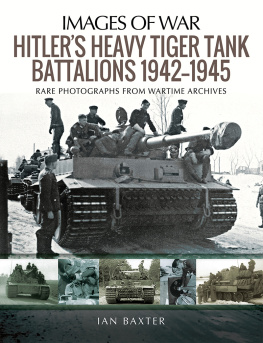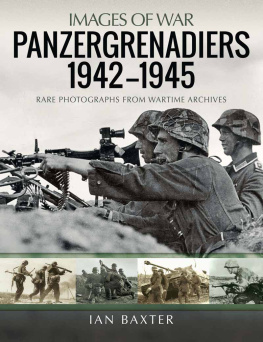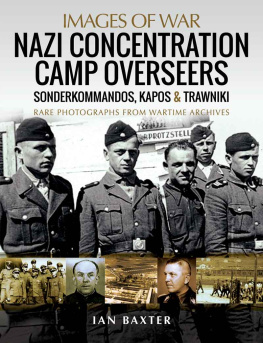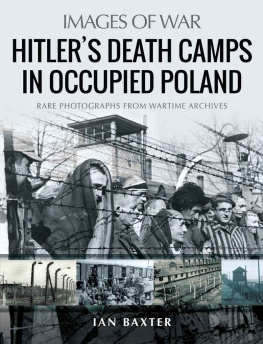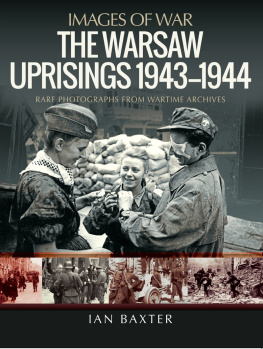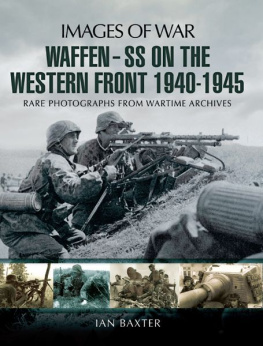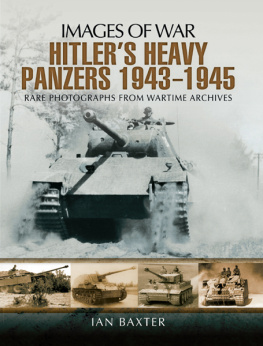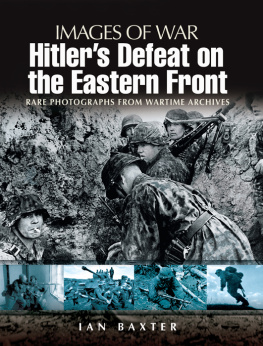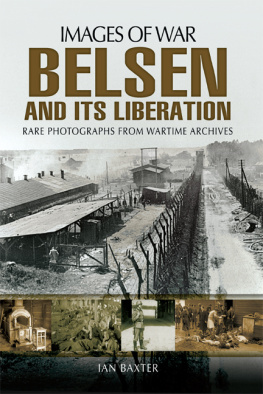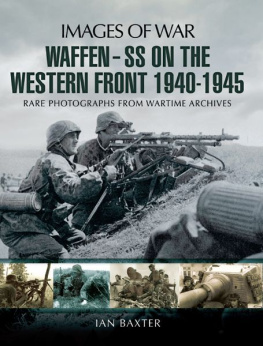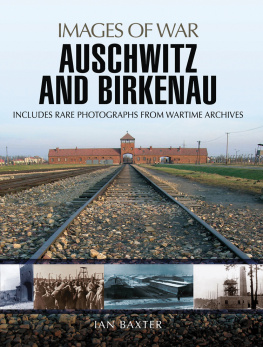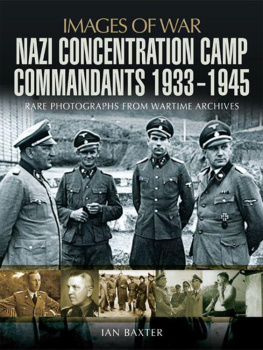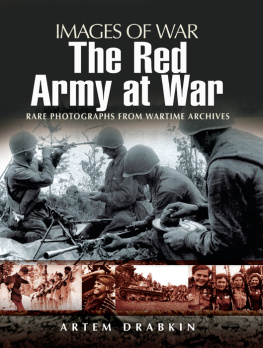Baxter Ian - Himmlers Nazi concentration camp guards : rare photographs from wartime archives
Here you can read online Baxter Ian - Himmlers Nazi concentration camp guards : rare photographs from wartime archives full text of the book (entire story) in english for free. Download pdf and epub, get meaning, cover and reviews about this ebook. City: Barnsley, Europe, year: 2012, publisher: Pen & Sword Military, genre: Religion. Description of the work, (preface) as well as reviews are available. Best literature library LitArk.com created for fans of good reading and offers a wide selection of genres:
Romance novel
Science fiction
Adventure
Detective
Science
History
Home and family
Prose
Art
Politics
Computer
Non-fiction
Religion
Business
Children
Humor
Choose a favorite category and find really read worthwhile books. Enjoy immersion in the world of imagination, feel the emotions of the characters or learn something new for yourself, make an fascinating discovery.
- Book:Himmlers Nazi concentration camp guards : rare photographs from wartime archives
- Author:
- Publisher:Pen & Sword Military
- Genre:
- Year:2012
- City:Barnsley, Europe
- Rating:4 / 5
- Favourites:Add to favourites
- Your mark:
- 80
- 1
- 2
- 3
- 4
- 5
Himmlers Nazi concentration camp guards : rare photographs from wartime archives: summary, description and annotation
We offer to read an annotation, description, summary or preface (depends on what the author of the book "Himmlers Nazi concentration camp guards : rare photographs from wartime archives" wrote himself). If you haven't found the necessary information about the book — write in the comments, we will try to find it.
Baxter Ian: author's other books
Who wrote Himmlers Nazi concentration camp guards : rare photographs from wartime archives? Find out the surname, the name of the author of the book and a list of all author's works by series.
Himmlers Nazi concentration camp guards : rare photographs from wartime archives — read online for free the complete book (whole text) full work
Below is the text of the book, divided by pages. System saving the place of the last page read, allows you to conveniently read the book "Himmlers Nazi concentration camp guards : rare photographs from wartime archives" online for free, without having to search again every time where you left off. Put a bookmark, and you can go to the page where you finished reading at any time.
Font size:
Interval:
Bookmark:
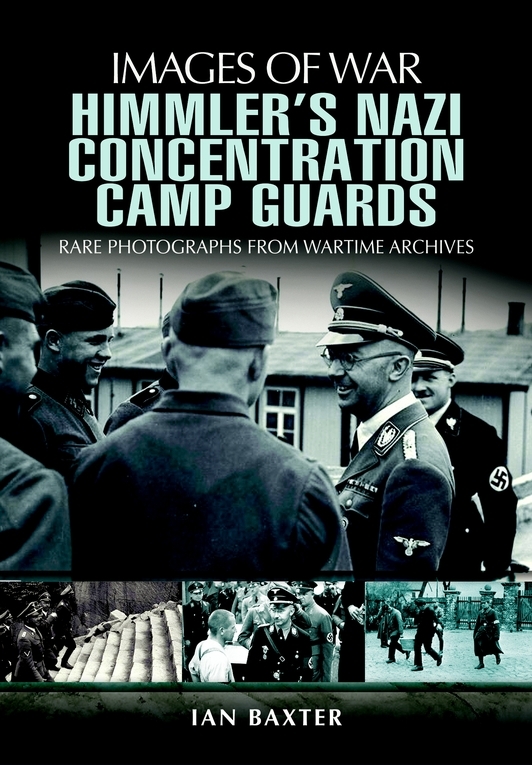
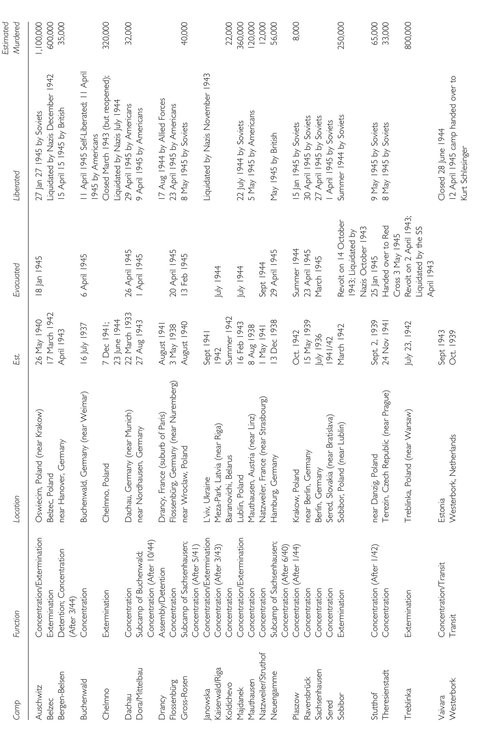
I an Baxter is a military historian who specialises in German twentieth century military history. He has written more than twenty books including Wolf: Hitlers Wartime Headquarters, Poland The Eighteen Day Victory March, Panzers In North Africa, The Ardennes Offensive, The Western Campaign, The 12th SS Panzer-Division Hitlerjugend, The Waffen-SS on the Western Front, The Waffen-SS on the Eastern Front, The Red Army at Stalingrad, Elite German Forces of World War II, Armoured Warfare, German Tanks of War, Blitzkrieg, Panzer-Divisions At War, Hitlers Panzers, German Armoured Vehicles of World War Two, Last Two Years of the Waffen-SS At War, German Soldier Uniforms and Insignia, German Guns of the Third Reich, Defeat to Retreat: The Last Years of the German Army At War 1943 1 945, Operation Bagration the destruction of Army Group Centre, German Guns of the Third Reich, Rommel and the Afrika Korps, the Sixth Army and the Road to Stalingrad and, most recently, Hitlers Eastern Front Headquarters: Wolfs Lair 1941 1945. He has written over a hundred journals including Last days of Hitler, Wolfs Lair, Story of the V1 and V2 Rocket Programme, Secret Aircraft of World War Two, Rommel At Tobruk, Hitlers War With His Generals, Secret British Plans to Assassinate Hitler, SS at Arnhem, Hitlerjugend, Battle Of Caen 1944, Gebirgsjger At War, Panzer Crews, Hitlerjugend Guerrillas, Last Battles in the East, Battle of Berlin, and many more. He has also reviewed numerous military studies for publication, supplied thousands of photographs and important documents to various publishers and film production companies worldwide, and lectures to various schools, colleges and universities throughout the United Kingdom and Southern Ireland.
He currently lives in Essex with Michelle and son Felix.
C ommander of the SS, Reichsfuhrer Heinrich Himmler, had made considerable efforts to recruit members of the old German elite into the SS. A number of these new recruits were assigned to the new concentration camps that had sprung up across Germany. A number of new recruits joined the ranks of the black SS order and were trained at places like Dachau concentration camp. Dachau was the first regular concentration camp established by the National Socialist government and was regarded by Himmler as the first camp for political opponents who were seen as an imminent threat to the new German government. Dachau was established on 20 March 1933, and it served as a prototype and model for the other concentration camps that followed. Its basic organisation, camp layout as well as construction of buildings were developed and ordered by SS-Brigadefhrer Theodor Eicke. In June 1933, Eicke had been made commander of Dachau concentration camp, and became a major figure in the SS. He was regarded as the architect, builder and director of the concentration camp system and ruled it with an iron fist. As a man he was stocky in appearance, blatantly brutal and ruthless, who gave off an aura of raw energy. It was here that many concentration camp guards were trained and were then assigned to other concentration camps.
Dachau was unlike any prison that the new SS recruits had been accustomed to. Unlike normal prison, the inmates did not know how long their sentence would run. In effect, they led a permanent existence of uncertainty as to when they would see freedom again. Life for the prisoners inside Dachau was brutal. The SS guards were all ordered to follow Eickes demand for blind and absolute obedience and to treat each prisoner with fanatical hatred. By perpetually drilling his SS guards to hate the prisoners, they were able to infuse themselves with anger and recrimination and mete out severe punishments. The training these recruits were given at the camp was relentless. Not only did they learn about enemies of the state, but they were also given an in-depth indoctrination in SS philosophy and racial superiority. These ideological teachings were aimed at producing men who ardently believed in the new Aryan order. They had to listen to the commandant regularly lecturing comrades about anti-Semitism. On the bulletin boards inside the SS barracks and canteen he often saw copies of the racist newspaper, Der Strmer. These propaganda newspapers had deliberately been pinned up in order to ferment hatred and violence especially against the prisoners.
All of the guards at Dachau were indoctrinated into an almost fanatical determination to serve the SS with blind allegiance. Eicke invested each guard with absolute life-and-death power over all the inmates of the camp. Rule breaking among the prisoners was classified as a crime. It was looked upon as an incitement to disobedience and each guard was given the power to hand out stringent punishments.
All SS guards were given extensive freedom to deal very harshly with any inmates they deemed to have committed a crime behind the wire. In addition to the general physical abuse meted out on the prisoners the camp commandant introduced other measures of cruelty towards these hapless individuals. Prisoners were deprived of warm food for up to four days, they were subjected to long periods of solitary confinement on a diet of bread and water. To supplement these harsh methods Eicke introduced corporal punishment into the daily routine. A prisoner would receive twenty-five strokes with the lash, carried out in the open square on specific orders from the commandant in the presence of assembled SS guards. In order to ensure every SS officer, non-commissioned officer and SS guard was instilled with the same brutal mentality as their commandant, Eicke regularly ensured that each man routinely took to punishing a prisoner with the lash without showing the slightest hesitancy, emotion and most of all, remorse. Only this way could he guarantee that the concentration camp staff would become more hardened and impersonal to the brutal code that Eicke himself had harshly implemented.
Eicke also programmed his guards to show particular hatred against Jews, immigrants, homosexuals and Jehovah Witnesses. Often, they listened whilst the commandant brazenly delivered lectures about what he considered were the most dangerous enemies of National Socialism. He instructed his guards to be brutal predominantly towards the Jews and use whatever violence necessary to keep them in check.
Although some new recruits disliked the brutality of the camp, as a whole they were inspired by its harsh order and discipline. Many were able to bury their emotions and become self-absorbed by the powers of camaraderie and loyalty to the SS. In their mind they saw the following months as a learning curve for their future. In spite of the crude and often brutal values of the SS they were given a clear example to follow. In their view they became increasingly convinced that the camp was the most effective instrument available to destroy all elements hostile to the banner of National Socialism.
The recruits also observed how Eicke had organised the inmates to work and expand the camps economic enterprises. They saw how the commandant put to work the prisoners to construct buildings and expand the camp to include a locksmiths shop, a saddlery and a shoemaking and table shop. Eicke was a great believer that the inmates were able to endure prison with more discipline if they were allowed to work. For him working whilst enslaved was a kind of mystical declaration that self-sacrifice through endless labour brought about a kind of spiritual freedom. It was this slogan and ardent belief that prompted Eicke to display the inscription Arbeit Macht Frei (work makes you free) on the main entrance gate of Dachau.
Font size:
Interval:
Bookmark:
Similar books «Himmlers Nazi concentration camp guards : rare photographs from wartime archives»
Look at similar books to Himmlers Nazi concentration camp guards : rare photographs from wartime archives. We have selected literature similar in name and meaning in the hope of providing readers with more options to find new, interesting, not yet read works.
Discussion, reviews of the book Himmlers Nazi concentration camp guards : rare photographs from wartime archives and just readers' own opinions. Leave your comments, write what you think about the work, its meaning or the main characters. Specify what exactly you liked and what you didn't like, and why you think so.


